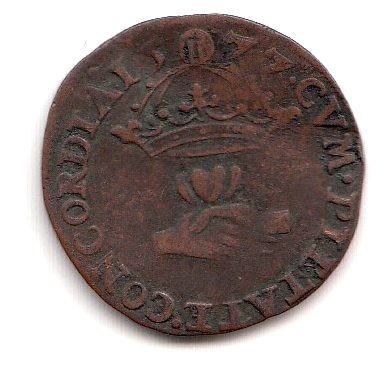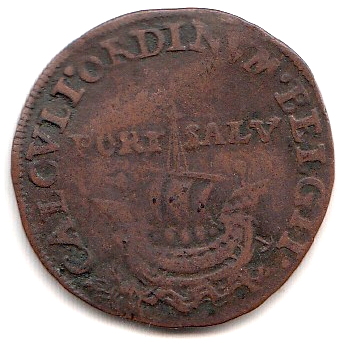 |  |
| CONCORDIA.1577.CVM.PIETATE. PORT SALV | CALCVLI.ORDINUM.BELGII. |
| Agreement.1577.With Piety | Calculi.United Provinces of the Netherlands Port Salu |
Calculi (literally “pebbles” in Latin) or tokens or “jetons” (in French) were minted in many cities of Europe from the the C13 through the C17 for use as counters for calculation in multiple settings. They were frequently used on a lined board to assist their arrangement. As Van Beek notes,1 they were always decorated according to the mediaeval tastes appropriate to the region in which they were to be used. The jetons used for calculation were typically copper (as opposed to more precious metals for coins) and in the C16 generally had the title of the issuing authority on one side together with a heraldic or similar icon, and on the opposing side an appropriate picture and motto (in this case “Accord with Godliness”. The method of using calculi for calculating is described well by Van Beek.2
Belgium did not exist in 1577. Rather it was broadly straddled by the Southern Netherlands (whose area roughly encompassed that of present-day Belgium and Luxembourg) as well as the northern provinces (whose area roughly corresponded to that of the present-day Kingdom of the Netherlands). The present-day translation from Latin of Ordinum Belgii is “The United Provinces of the Netherlands”3 (or literally, but deceptively, the “United States”).
Notes
1. This particular calculi has the following reference in Le jeton historique des dix-sept provinces des Pays-Bas4.
2. It is likely “Port Salu” as used here does not signify a particular place, but rather follows use in contemporaneous literature as a “safe port”.
See for example:
- Meaning of port salu
again in his Garlande of Laurell, v. 541. Compare Hoccleve, Poems, p. 61 (ed. 1796), “ whether our taill Shall soone make us with our shippes saill To port salu,” where the editor observes: “Port salu wsis a. kind oi proverbial expression, and so used in the translation of Cicero de Senectute, printed by Caxton.” (D.)5
- Skelton: Garlande of Laurell.6
- Early English law quoted in a book of English Law post Magna Carta, contains a reference in the French translation, of an edict from the twelfth year of Edward IV which specifies that because of a scarcity of bow staves in the Kingdom each “carrack, galley or ship” entering it must bring four good bow staves for every ton of cargo on pain of forfeiture of the cargo and ship, and that two men expert in such matters will be assigned to search every such vessel that “shall hereafter come to safe port” or in the French translation “de faire son port salu.”(emphasis added) 8
- Port Salu is not “Port Salut” neither as the name of a coastal town in the Sud Department of Haiti nor relating to the cheese named “Port Salut”. The name of the cheese derives from 1816 when, after fleeing events related to the French Revolution, monks settled at the Mayenne river at a point called Port Rhingeard and named it Port Salut after “Ici est notre Salut!” (“Here is our salvation!”)9
References
- Bert van Beek (1986). “Jetons: Their Use and History”, Perspectives in Numismatics, Chicago Coin Club, http://www.chicagocoinclub.org/projects/PiN/juh.html, viewed 23 June 2012 (and references therein)
- Wikipedia. http://en.wikipedia.org/wiki/Jeton viewed 22 June 2012.
1 Bert van Beek (1986). “Jetons: Their Use and History”, Perspectives in Numismatics, Chicago Coin Club, http://www.chicagocoinclub.org/projects/PiN/juh.html, viewed 23 June 2012 (and references therein). (↑)
2 ibid (↑)
3 See for example, Celsorum & praepotentium federati Belgii ordinum ad S. Caes. Majestatem epistle. (Book, 1665) [WorldCat.org], http://www.worldcat.org/title/celsorum-praepotentium-federati-belgii
-ordinum-ad-s-caes-majestatem-epistola/oclc/068916864]] viewed 24 June 2012 (↑)
4 Jean François Dugniolle, Le jeton historique des dix-sept provinces des Pays-Bas, Société njile do oninitiqie belge, Bruxelle, Tome Premier — QUINZIÈME SIÈCLE, 1875.http://www.archive.org/stream/lejetonhistoriq00dugngoog/
lejetonhistoriq00dugngoog_djvu.txt viewed 21 June 2012 (↑)
5 John Skelton. Skelton. A selection from the poetical works of John Skelton
http://www.ebooksread.com/authors-eng/john-skelton/skelton-a-selection-from-the-poetical-works-of-john-skelton-hci
/page-11-skelton-a-selection-from-the-poetical-works-of-john-skelton-hci.shtml viewed 24 June 2012]] (↑)
6 ibid verse 194. (↑)
7 Henry Morley, English writers; an attempt towards a history of English literature, Griffin, William Hall, London, Paris, New York & Melbourne, Cassell & Company Ltd, 1887
http://www.archive.org/stream/cu31924016645289/cu31924016645289_djvu.txt viewed 24 June 2012]] (↑)
8 Danby Pickering, The statutes at large: from the First Year of King Henry V to the Twenty-Second Year of King EDW. IV. inclusive, Vol. III., Cambridge, Cambridge University, 1762, pp. 408–9 http://books.google.com.au/books?id=J1MDAAAAQAAJ&pg=PA409&lpg=PA409&dq=%22port+salu%22
&source=bl&ots=s4FbGZAXTt&sig=X87WWJvJ2h5gMRnywYZ65gKMoSg&hl=en&sa=X&ei=awXnT4m0BoajiAfT8oRZ&ved
=0CGQQ6AEwBw#v=onepage&q=%22port%20salu%22&f=false viewed 24 June 2012 (↑)
9 Discover Port Salut® viewed 24 June 2012 (↑)
Pages linked to this page
 This work by Jim Falk is licensed under a Creative Commons Attribution-NonCommercial-NoDerivs 3.0 Unported License Click on the logo to the left to see the terms on which you can use it.
This work by Jim Falk is licensed under a Creative Commons Attribution-NonCommercial-NoDerivs 3.0 Unported License Click on the logo to the left to see the terms on which you can use it.